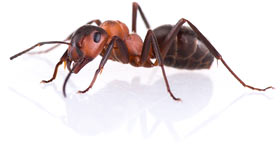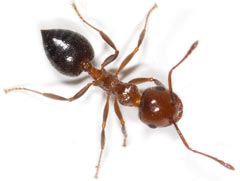There is a pest that has invaded the southern United States. The fire ant is everywhere and it’s a tiny but dangerous insect.
Wherever you look … on lawns, golf courses, even in cracks in the pavement, you will often come across mounds made by fire ant colonies. Fire ants are tiny … just over three millimeters long … and you can’t easily see them unless you bend over and look closely. But if you accidentally step on one of their mounds, instantly thousands of fire ants will swarm out of the ground looking for something to attack. Fire ants don’t bite; they sting like wasps. They hold on with their mouthparts and inject venom into the skin through a stinger on their abdomen. You’re likely to be stung hundreds of times if you unknowingly disturb a mound.

Naturally, we had to investigate what would happen if we did disturb a mound. We carefully stepped onto one, and then very quickly took our feet away. The reaction was instantaneous. Tiny fire ants by the thousands came boiling out of cracks in the dirt, and within seconds the surface of the mound was covered in ants.
Fire ants are active and aggressive, swarming over anyone or anything that disturbs their nest … animals, birds, livestock, pets, or people. An accidental encounter with a fire ant nest could leave you with burning pain, followed by tiny, itching pustules, and sometimes even more severe reactions including anaphylactic shock. These ants will swarm over anything that threatens their mound or that looks like food, whether it be old people, crawling babies, injured birds, bedridden hospital patients, or you just out walking.
Fire ants are originally from South America, where dozens of fire ant species exist. There have been two introductions of fire ants which have led to current problems. The black and red fire ant both arrived in Alabama in the early to mid-1900s from South America, probably in ship cargoes. From there they spread all over the southern United States.
Fire ants individually are hard to identify because they look much like ordinary ants. They are a few millimeters long and reddish-brown to black in color. Fire ants in a colony are probably most easily distinguished by their aggressive behavior and characteristic mound-shaped nest. Their nests have no obvious openings, but just under the surface are many tunnels, allowing thousands of ants to emerge in just a few seconds.
Fire ants don’t always live in soil; any dark, protected site with moisture and a supply of food will do. Fire ants will nest in rotten logs, walls of buildings, under sidewalks and roads, in automobiles, and even in dried cow manure.
The reason that fire ants are such a concern is that the ants don’t take a bite out of you, like other ants, but instead actually sting you, injecting venom from a stinger on their abdomen. Moreover, each ant can continue to sting you over and over. Hundreds of aggressive ants stinging continuously can cause serious pain and swelling and can be fatal to children, small animals, or people with allergies.
In rural areas, fire ants are having a major impact on ground-nesting animals, including insects, reptiles, birds, and mammals. In some areas, fire ants have completely eliminated some species from the ecosystem.
Fire ant colonies consist of eggs, larvae and pupae, and adult ants. Adult ants include winged males, winged females, one or more egg-producing queens, and workers. Within a colony, the worker ants come in various sizes, all small, and they are all sterile, wingless females. Young workers care for the queens, pupae, and eggs, while older workers search for food and defend the colony.
The average fire ant colony contains 100,000 to 500,000 workers, and up to several hundred winged ants. Most mounds contain only one egg-laying queen, however, multiple queen colonies are known to occur in some parts of the southern U.S. states. The mound of a new colony is not noticeable until several months after a new queen begins laying eggs.
The below-ground portion of a fire ant mound is a complex of tunnels and chambers that may extend a meter underground. The upper portion of the mound, above ground, can reach a height of 30 to 50 centimeters, but in sandy soils, the mounds are very low, sometimes evident only by the color of the soil. Mounds we observed were often almost impossible to see until you stepped on them … a definite hazard if you were to stop walking while standing on one!

Fire ants are omnivorous, feeding on almost any plant or animal material, although insects seem to be their preferred food. Fire ants in towns and cities nest in the walls of homes and offices, under sidewalks and roads. The presence of fire ants can deter outdoor activities in yards, parks, and school grounds. Home invasions can threaten small children and the elderly.
Fire ant colonies have been found inside automobiles, trucks, and recreation vehicles Traffic accidents have been caused by fire ants stinging the drivers of automobiles. Victims of highway accidents can be attacked by fire ants if they are thrown from their vehicles.
Fire ants are attracted by electrical current and have caused considerable damage to heat pumps, air conditioners, telephone junction boxes, transformers, traffic lights, and gasoline pumps.
Damage estimates in the U.S. range from millions to billions of dollars annually. In Texas alone, it is estimated that fire ants cost the state $300 million annually. The beef cattle industry alone suffers losses estimated at $67 million per year.
Hundreds of millions of dollars are spent annually for control of the fire ant.
